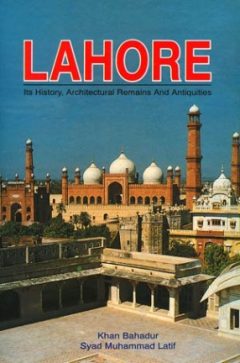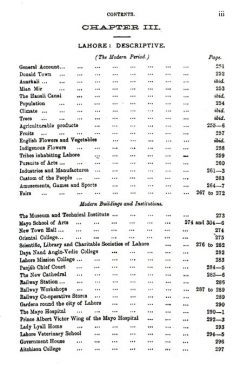The book under review was first published in 1892 by the New Imperial Press, Lahore. Before that some half-hearted attempts were made to write the history of Lahore. A work of reference called A Brief Account of the History and Antiquities of Lahore was published in 1873 by T.H. Thornton. Subsequently, a revised addition of this book, co-authored with J.L. Kipling, principal of the Mayo School of Arts (presently National College of Arts) was published in 1876. This book was limited in scope and left many important things unmentioned. At that time, old buildings of the Mughal era were facing extinction and there was a dire need to preserve them in writing. The only works extant on the old buildings of Lahore were Tahqiqat-i-Chishti of Maulvi Noor Muhammad and a book in Urdu published by Rai Bahadur Kanahia Lal, called the Tarikh-i-Lahore 1884 in the compilation of which Rai was assisted by Mufti Ghulam Sarwar of Lahore. Tahqiqat-i-Chishti was full of supernatural stories which had nothing to do with the actual deeds of the local saints. Maulvi Noor Ahmad Chishti was born in Lahore in 1828 and died in 1868. Rai Bahadur Kanahia Lal was well versed in Hindi, Persian and Urdu languages. He was a pupil of Mufti Ghulam Sarwar, who was a renowned scholar of his time. He wrote many books in Urdu and Persian like Gulzar-i-Hindi, Bandagi Nama and Munajate Hindi. S.M. Latif has divided the book in four chapters. Chapter one deals with the history of Lahore from the earliest known period to the middle of the 19th century. In it, the author has tried to locate the origin of the name, Lahore, and the date of its foundation. The history of Lahore from the pre-Muslim period up to the annexation of the Punjab by the British has been covered by mentioning every important event. Chapter two and three are devoted to the ancient and modern buildings, institutions and spots which claim attention due to their elegance or historical interests. Chapter three takes into account the inhabitants of Lahore, their customs, pursuit of arts and industries, their public amusements, games and fairs. Chapter four is devoted to the antiquities of Lahore developed at various stages of history, that is, monuments, coins, sculpture and artifacts lying in the museum of Lahore. The mythical founder is said to be Lov or Loh, son of Rama, the hero of Ramayana. But coming into the fold of actual history, its origin can be traced to the Rajput princes of Ajudhia. However, nothing definite can be said about it. At least the mythological version cannot be substantiated on any of the pretexts. However, at the time of early Muslim expeditions, Lahore was in possession of the Chohan Rajput princes of the royal family of Ajmer. Ibn-i-Rehan-Al-biruni, in his celebrated work The Qanoon, calls it Lahawar, while Amir Khusrau in his well-known work, Kiranus Saden pronounces it as Lahanur. Thronton suggests that Lahanur is a corruption of Lahuanagar, nur being the Dukhani form of nagar. The author has traced the name Lahore both etymologically and historically. He has taken into account all sources available at the time. Following his methodology, one can easily say he worked like a modern research scholar, sparing nothing significant to note. In the historical context which he has traced from ancient times to the annexation of the Punjab when the British army entered Lahore on February 20, he has elaborated on everything worth mentioning. He is very helpful for the common reader for whom the reading of this book is not tiresome. Though he has devoted a large portion of the book to the Mughal period, the mind of the author is more inclined towards places, buildings and institutions. After chapter one, he fixes his pen for describing architectural remains, mausoleums, gardens, mosques, armories and prominent buildings. He also accommodates populations, climate, flaura and fauna, pursuits of arts, industries and manufacturers, tribal customs, amusments, games and sports and fairs. In this regard, it is a small encyclopaedia of Lahore covering the 19th and 20th centuries. I found no book so comprehensive except the Naqoosh Lahore number published in February, 1962, covering the period from 1014 to 1961AD. The present edition is illustrated with more than 100 engravings and around 20 photographs of important buildings along with a map of Lahore. The old buildings mostly belong to the Mughal or the British periods. Any tomb, mausoleum, temple or institution belonging to Ghaznavide, Ghauri, Khilji and Lodhi period are hardly found. S.M. Latif only mentions Bharion Ka Than and Chandani Raat near Ichra, the temple of Loh in the Fort and a Dharamsala near the tehsil. Of the remains of the Pathan period, we only find Niwi Masjid and Sharon Wali Masjid.
Buddhist, Hindu and Jain Art
$49.50
$55.00











There are no reviews yet.